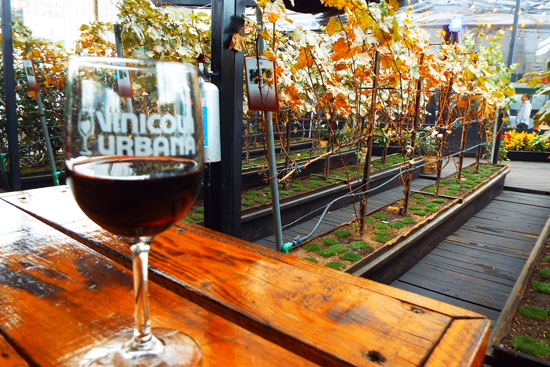Our contributor takes us to Vinicola Urbana, a wine-producing rooftop vineyard (and breath of fresh air) smack-dab in overcrowded Mexico City.

All photos by Lydia Carey
A pseudo-camouflaged sign sits at the entrance of No. 29 on Mexico City’s posh Avenida Presidente Masaryk. Inside, the security guards will probably ignore you, but all the way to the left-hand side of the lobby sits a woman who will direct you to the elevators, up four floors, and into an empty elevator-bank hallway. You’ll hesitate, confused; walking out what looks like an emergency exit, you turn right and are unexpectedly met by a wave of shamrock-shaped leaves, tiny bundles of grapes hanging daintily beneath their emerald shadows.
“A vineyard?” you think. “In the middle of a 25-million-strong metropolis?”
Welcome to Mexico City’s Vinicola Urbana.

The story starts with two guys—Guillermo Tame and famous Baja wine oenologist Hugo D’Costa—who wanted to make Mexico City wine, chilango wine, straight and simple. They wanted wines that would appeal to a range of urban palates. In a country just starting to rediscover wine, the prospect was more than a little daunting, but their bullheaded passion drove them forward.
First, some history. At the beginning of the 20th century, wine was being produced in almost every state of the Mexican Republic. Consumption was at an all-time high thanks to then President Porfirio Diaz’s love of all things French, including their drink of choice. Vineyards had in fact been producing in Mexico since the Spaniards’ arrival in the 1500s (trivia tidbit: Mexico was the first place where native roots were grafted onto European vines to safeguard them against New World diseases and insect plagues). A robust Mexican elite class was consuming wine by the barrelful until the upheaval of the Mexican Revolution combined with a phylloxera plague wiped out a good percentage of the country’s working vineyards.
During that time, vineyards in Baja California continued to survive, and over the past several decades, wine-making has slowly made its way back to Coahuila, Sonora, Durango, and the country’s Bajio region around Queretaro. Now, thanks to this single vineyard, Mexico City is also considered one of the country’s “wine-producing regions.” What was once Tame’s grandmother’s rooftop is now one of the world’s only rooftop vineyards, and the only one that does all of its wine processing on-site.

A city hounded by its reputation for overcrowding and pollution may not seem like the perfect fit for producing wine, but the growing demand for wine coupled with a frenzy for eating locally has made the vineyard a hit. The Vinicola vines are just now three years old; they have a year left before they can be picked and turned into Vinicola Urbana’s first Mexico City vintage. For now, grapes are transported from Baja California fields and crushed, strained, fermented, and aged right on the fourth floor of this Polanco high-rise.
With a shaded roof above them and a drip irrigation system below, the vines provide a striking green respite in this most urban of urban metropolises. Here you’ll find 300 vines growing in a 500-square-meter space with a view of the skyline. Once bottled, each varietal is branded with an iconic symbol of the city: El Angel (nebbiolo), Diana (cabernet sauvignon), Revolución (a red blend), Zocalo (tempranillo and grenache), and Bellas Artes (sauvignon blanc) represent the varying degrees of complexity in the palates of urban Mexicans today.

Daniel Almeyra is a serious South American wine drinker and the vineyard’s sommelier. His gripes about Mexico City restaurants’ wine service has translated into a rigid training program for his staff. “You ask waiters about wine in Mexico City and they freeze up,” he tells me. “Like it’s the worst question you could have asked. Or they say something like, ‘It’s good, just trust me.’”
Almeyra’s staff is not going to tell you to just trust them. But trust them you should: These waiters (who speak English) know their wine, what it pairs with, what the flavor profile is. This is where reasonably priced bottles (from about US$13 to $38, depending on the exchange rate) meet top-notch service. In other words: If you’re a wine lover and you’re in Mexico City, this is your spot.
And then there’s that setting, so unexpectedly calming. High above the traffic and the noise, as I sipped a delicious cherry-tobacco nebbiolo surrounded by next year’s harvest, it was hard to deny the allure of this tiny piece of wine country in the middle of the urban jungle.
How to drink: The space is open to the public Mon and Tues from 1pm-7pm; Wed-Fri, 1pm-10pm. A tasting that includes all the Vinicola wines will set you back about US$10. You can also buy wine by the bottle or the glass, and there is a small restaurant for a light dinner (and pairing with your vintage of choice).
Or, find the Vinicola’s wines at restaurants around town and in the wine section of Palacio de Hierro department stores.
About the author: Lydia Carey is a freelance writer and translator in her adoptive hometown, Mexico City. You can find her online at her blog, MexicoCityStreets.com.










.jpg)

